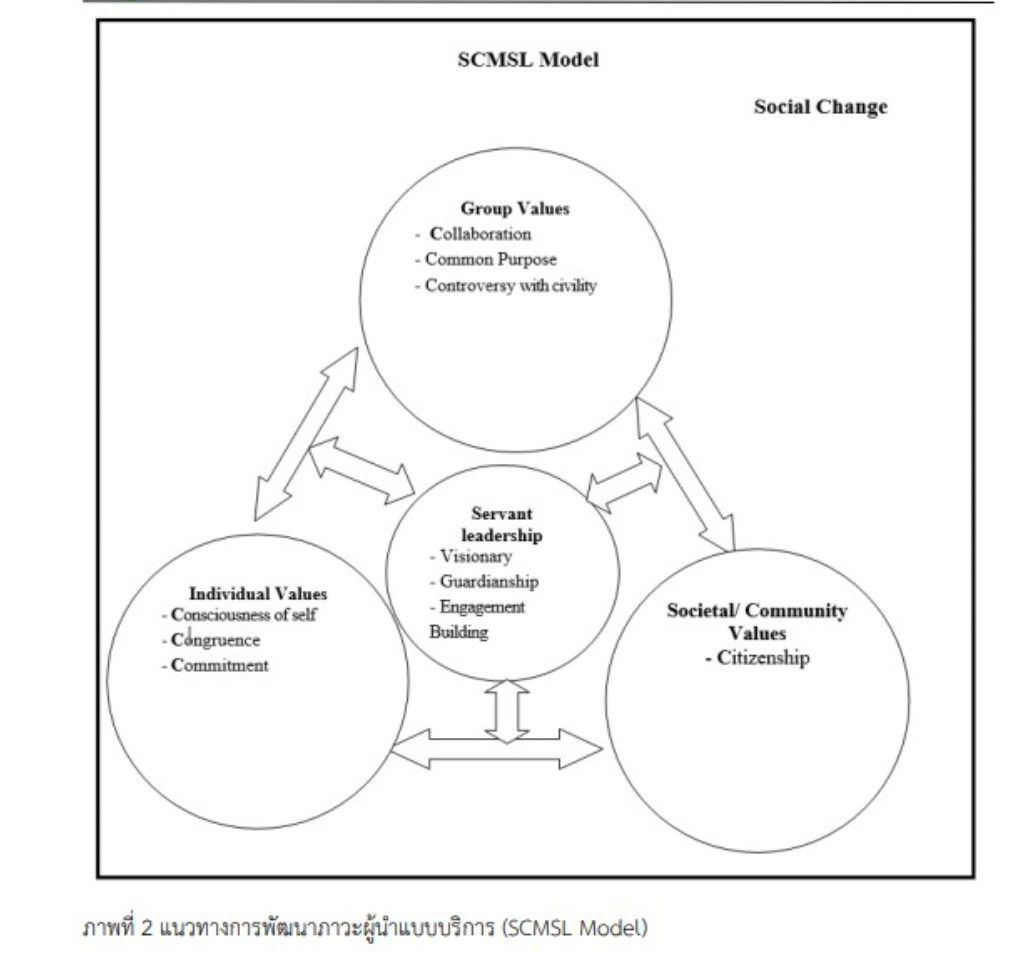พฤติกรรมภาวะผู้นำแบบบริการของผู้บริหารมหาวิทยาลัยราชภัฎ
Main Article Content
บทคัดย่อ
การวิจัยครั้งนี้มีวัตถุประสงค์เพื่อศึกษาพฤติกรรมภาวะผู้นำแบบบริการ และศึกษาแนวทางในการพัฒนาภาวะผู้นำแบบบริการของผู้บริหารมหาวิทยาลัยราชภัฏ โดยใช้ระเบียบวิธีการวิจัยแบบผสม (Mixed-methods) เก็บรวบรมข้อมูลเชิงปริมาณจากกลุ่มตัวอย่างผู้บริหารในมหาวิทยาลัยราชภัฏ จำนวน 260 คน ด้วยแบบสอบถามมาตรประมาณค่า สัมภาษณ์เชิงลึกผู้ทรงคุณวุฒิ 5 คน และสนทนากลุ่มผู้บริหาร 8 คน วิเคราะห์ข้อมูลเชิงปริมาณด้วยสถิติพรรณา และวิเคราะห์ข้อมูลด้วยการวิเคราะห์เนื้อหา ผลการวิจัย พบว่า ในภาพรวมและรายองค์ประกอบพฤติกรรมภาวะผู้นำแบบบริการอยู่ในระดับสูง โดยเรียงลำดับค่าเฉลี่ยจากสูงไปหาต่ำ คือ การสร้างความร่วมมือร่วมใจ การมีวิสัยทัศน์ และการคุ้มครองดูแลรักษา และจากการวิเคราะห์เนื้อหา พบว่า แนวทางการพัฒนาภาวะผู้นำที่พัฒนาขึ้นนั้นเป็นแกนกลางของการขับเคลื่อนภาวะผู้นำการเปลี่ยนแปลงทางสังคม ที่อยู่ในวงรอบของการปฏิสัมพันธ์ระหว่างค่านิยมระดับบุคคล ค่านิยมระดับกลุ่ม และค่านิยมระดับชุมชน/สังคม
Article Details
เอกสารอ้างอิง
พสุ เดชะรินทร์. (2547). Balance Scorecard รู้ลึกในการปฏิบัติ. พิมพ์ครั้งที่ 3. กรุงเทพฯ: โรงพิมพ์แห่งจุฬาลงกรณ์มหาวิทยาลัย.
สรายุทธ กันหลง. (2553). ยุทธศาสตร์การพัฒนาภาวะผู้นำใฝ่บริการของผู้บริหารมหาวิทยาลัยราชภัฏในภาคตะวันออกเฉียงเหนือ. วิทยานิพนธ์รัฐประศาสนศาสตรดุษฎีบัณฑิต สาขาวิชารัฐประศาสนศาสตร์ มหาวิทยาลัยราชภัฏวไลยลงกรณ์ ในพระบรมราชูปถัมภ์.
สัมฤทธิ์ กางเพ็ง และสรายุทธ กันหลง. (2553). ภาวะผู้นำใฝ่บริการในองค์การ : แนวคิดรวบยอด หลักการ ทฤษฎี งานวิจัย. พิมพ์ครั้งที่ 2. ขอนแก่น: คลังนานาวิทยา.
สํานักงานคณะกรรมการพัฒนาการเศรษฐกิจและสังคมแห่งชาติ. (2559). พระราชบัญญัติมหาวิทยาลัยราชภัฎ พ.ศ. 2547. https://www.mhesi.go.th/images/2563/pusit/legal-all/6p2547.pdf
สำนักงานคณะกรรมการกฤษฎีกา. (2547). พระราชบัญญัติ มหาวิทยาลัยราชภัฏ พ.ศ. 2547. https://www.mhesi.go.th/images/2563/pusit/legal-all/6p2547.pdf
Abel, A. T. (2000). The Characteristics, Behaviors, and Effective Work Environments of Servant Leaders: A Delphi Study. Dissertation, Ph.D.(Educational Leadership and Policy Studies) . Virginia. Graduate School: Blacksburg. Photocopied.
Black, G. L. (2007). A correlational analysis of servant Leadership and school climate. Ed.D. dissertation, University of Phoenix, United States -- Arizona. Retrieved January 31, 2009, from Dissertations & Theses: A&I database. (Publication No. AAT 3309254).
Covey, S. R. (2001). “Foreword.” In R. K. Greenleaf. Servant Leadership: A Journey into the Nature of Legitimate Power and Greatness. Mahwah, NJ: Paulist Press.
Daft, R.L. (2002). The Leadership Experience. 2nd ed. Fort Worth, TX : Harcourt College.
Irving, J. A. (2005). Servant leadership and the effectiveness of teams. Doctoral dissertation, Regent University.
Irving, J. A., & Longbotham, G. J. (2007). Team effectiveness and six essential servant leadership themes: A regression model based on items in the organizational leadership assessment. International Journal of Management Studies, 2, 98–113.
Laub, J. (2018). Leveraging the Power of Servant Leadership Building High Performing Organizations. West Palm Beach, FL: Palm Beach Atlantic University.
Layola Marymount University. (2010). Social Change Model of Leadership Development. http://www.lmu.edu/studentlife/student_leadership_ development/About/leadership_Programs/Social_Change_Model_for_Leadership_Development.htm
Northouse, P.G. (2009). Introduction to Leadership: Concepts and Practice. Thousand Oaks, LA: Sage.
Nwogu, O.G. (2004). “Servant Leadership Model: The Role of Follower Self-esteem, Emotional Intelligence, and Attributions on Organizational Effectiveness.” Servant Leadership Research Roundtable. Regent University.
Page, D. and Wong, Paul T.P. (2003) A Conceptual Framework for Measuring Servant Leadership. Trinity Western University, Canada. http://www.twu.ca/academics/graduate/leadership/servant-leadership/conceptualframework.pdf
Palmer, P. (2004). A Hidden Wholeness: The journey toward an undivided life. San Francisco, CA: Jossey-Bass.
Smith, C. (2005). The Leadership Theory of Robert K. Greenleaf. http://www.carolsmith.us/downloads/640greenleaf.pdf
Spears, L.C. (2004). The Understanding and Practice of Servant-leadership. In L. C. Spears, & M. Lawrence (Eds.), Practicing servant leadership: Succeeding.
Spears, L.C. and J. Noble. (2000). James Autry in Des Moines, Iowa. http://www.greeneaf.org/leadership/read-about-it/Servant-Leadership-Articles-Book-Reviews.html
Synovus Financial Corp. (2005). Honors and Awards. http://www.synovus.com/index.cfm? catid=4&subject=4&page=2
TD Industries. (2006). TD Industries. http://www.tdindustries.com/default.asp
Thompson, J.A. (2005). Proactive Personality and Job Performance: A Social Capital Perspective. Journal of Applied Psychology. https://www.researchgate.net/publication/7601012_Proactive_Personality_and_Job_Performance_A_Social_Capital_Perspective
University of Baltimore. (2010). Social Change Model of Leadership Development. [Online]. Available: http://www.ubalt.edu/template.cfm?page=2545
Yalom, I.D. (1995). The theory and practice of group psychology. 4th ed. New York : Basic Books.
Yukl. G. (2002). Leadership in Organizations. 5th ed. Englewood Cliffs, NJ: Prentice-Hall.


